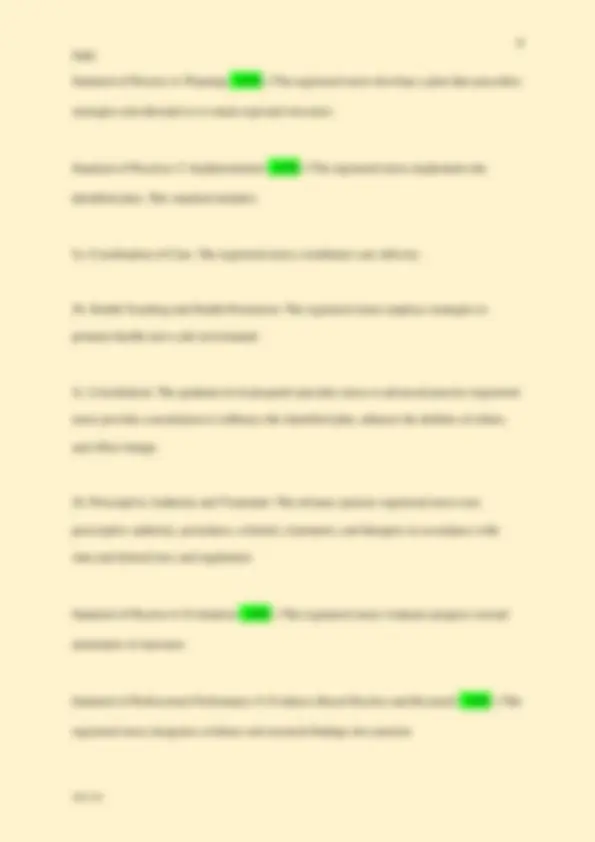








Study with the several resources on Docsity

Earn points by helping other students or get them with a premium plan


Prepare for your exams
Study with the several resources on Docsity

Earn points to download
Earn points by helping other students or get them with a premium plan
Community
Ask the community for help and clear up your study doubts
Discover the best universities in your country according to Docsity users
Free resources
Download our free guides on studying techniques, anxiety management strategies, and thesis advice from Docsity tutors
Nursing Evolution During World War 1 - ANS ✓More nurses were needed with the onset of WW1; thus opportunity for development of the profession occurred--John Hopkins and Columbia University started a BSN level nursing education. Linda Richards - ANS ✓The first nurse to graduate in the United States from a formal nursing program (the program she attended was founded by Dr. Susan Dimock at the New England Hospital for Women and Children in 1873; Dimock died in 1875) The Goldmark Report - ANS ✓During WW1, the Goldmark Report called for all nurses to be education in universities and for hospital based training to be terminated. Role of Nurses in Public Health (early 1900's) - ANS ✓During the early 1900's, public health became an area for the most autonomous practice of nursing. The focus was on helping the poor and destitute.
Typology: Exams
1 / 12

This page cannot be seen from the preview
Don't miss anything!







Nursing Evolution During World War 1 - ANS ✓More nurses were needed with the onset of WW1; thus opportunity for development of the profession occurred--John Hopkins and Columbia University started a BSN level nursing education. Linda Richards - ANS ✓The first nurse to graduate in the United States from a formal nursing program (the program she attended was founded by Dr. Susan Dimock at the New England Hospital for Women and Children in 1873; Dimock died in 1875) The Goldmark Report - ANS ✓During WW1, the Goldmark Report called for all nurses to be education in universities and for hospital based training to be terminated. Role of Nurses in Public Health (early 1900's) - ANS ✓During the early 1900's, public health became an area for the most autonomous practice of nursing. The focus was on helping the poor and destitute. Key players were Lillian Wald and Mary Brewster.
Lillian Wald and Mary Brewster - ANS ✓Lillian and Mary started the Nurses Settlement House in the NYC tenements, which became the Henry Street Settlement. This effort then developed into the Visiting Nurses Society, and served as a model for other community nursing efforts. Margaret Sanger - ANS ✓Margaret Sanger is a key example of nurses advocating for patients. She fought to make birth control available and safe for all women. Her organization became what we know as Planned Parenthood Nursing Education Changes in the Mid 20th Century - ANS ✓During this time, nursing education moved out from physician driven hospital programs to college and university based programs. At the same time, in response to many nursing shortages, community colleges developed 2 year ADN programs 1985 Proposal - ANS ✓In the 1980's, the ANA proposed the "1985 Proposal" to move all entry level RNs to the BSN level. This proposal was not met and is still not met; however, the push for hospitals to have Magnet Status is currently driving this initiative Advanced Nursing Degrees - ANS ✓APN programs developed in the mid-1970's to educate BSN level nurses to more advanced and focused clinical practice (this Master's level degree is being replaced by the Doctor of Nursing Practice, DNP) PhD in nursing programs developed in the late 1980's to early 1990's.
Nursing and Advanced Degrees (general) - ANS ✓The first dean of Rush's CON, Luther Christman, called for all nurses to be educated at the PhD level. This push will continue to bring MSN prepared or DNP prepared nurses to the bedside as care becomes more complex. Nursing and Advance Degrees (stats) - ANS ✓There are 303 DNP and 130 PhD programs in the United States. With the advent of DNP programs, PhD enrollment has stayed steady but has not seen any increase since the launch of DNP programs. ANA Definition of Nursing - ANS ✓Nursing is the protection, promotion, and optimization of health and abilities, prevention of illness and injury, alleviation of suffering through the diagnosis and treatment of human response, and advocacy in the care of individuals, families, communities, and populations. Nursing Scope and Standards of Practice (general) - ANS ✓The scope and standards of practice were developed and updated periodically by the American Association of Nurses. The score and standards apply to all professional nurses. They serve as a template for evaluating nursing specialty practices, and describes the competent level of nursing practice and professional performance for all registered nurses. Scope of Nursing Practice - ANS ✓The scope of nursing practice details the who, what, where, when, why,, and how of the nursing practice:
Who: RNs and APNs What: definition of nursing practice (in Nursing Social Policy) Where: anywhere there is a healthcare consumer in need of care, information, or advocacy When: whenever there is a need for nursing knowledge Why: nursing's response to the changing needs of society for healthcare How: the ways means, and methods nurses use to practice Critical Thinking (as it relates to nursing) - ANS ✓Critical thinking is that mode of thinking in which the thinker improves the quality of his or her thinking by skillfully analyzing, assessing, and reconstructing it. Critical thinking is self-directed, self-disciplined, self-monitored, and self-corrective thinking. It presupposes assent to rigorous standards of excellence and mindful command of their use. It entails effective communication and problem-solving abilities, as well as a commitment to overcome our native egocentrism and sociocentrism. Standards of Nursing Practice - ANS ✓The standards are authoritative statements of the duties of all registered nurses, regardless of role, population, or specialty. The standards are subject to formal, periodic review, and revision.
Evidence of Meeting the Standards - ANS ✓Each standard has corresponding competencies to evaluate how a RN is meeting that standard (e.g., S1: Assessment has 13 competencies that a BSN prepared RN is expected to meet, and 15 for a MSN prepared RN) ANA's Five Healthy Nurse Constructs - ANS ✓1. Calling to Care: Interpersonal, compassionate offering of self
Standard of Professional Performance 11: Communication - ANS ✓The registered nurse communicates effectively in a variety of formats in all areas of practice Standard of Professional Performance 12: Leadership - ANS ✓The registered nurse demonstrates leadership in the professional practice setting and the profession Standard of Professional Performance 13: Collaboration - ANS ✓The registered nurse collaborates with healthcare consumer, family, and others in the conduct of nursing practice Standard of Professional Performance 15: Resource Utilization - ANS ✓The registered nurse utilizes appropriate resources to plan and provide nursing services that are safe, effective, and financially responsible Florence Nightingale's Impact on Nursing - ANS ✓During the Crimean War (1850's), Nightingale changed the way soldiers were cared for; fought to allow her nurses to the front lines; reduced mortality from 40% to 2.2% Florence Nightingale's Evidence & Improvements at the soldier's hospital (during Crimean War) - ANS ✓In the soldier's hospital, in the year 1854 and against strong physician opposition, Nightingale worked with 38 nurses that she hired to improve the environment and personal condition of every soldier. She and her nurses also promoted their health by cleanliness, fresh air, clean water, and good nutrition
Florence Nightingale post-Crimean War - ANS ✓Following the war, Nightingale returned to England and, against physician opposition (only 4 of 100 physicians approved), established a nursing school at St. Thomas Hospital thanks to a donation from the public equal to $200k. At the nursing school, Nightingale developed an educational program based on the science of the time. Nursing School at St. Thomas Hospital - ANS ✓Nightingale's curriculum had a key component--that nurses need to observe changes in their patients and report them to the physician. Florence understood the important of the consistent presence of nurses with a patient, and that that is central to the nursing role Florence Nightingale's Nursing Education Model - ANS ✓Nightingale combined didactic content and bedside experience; this model is still followed in all nursing programs today Key to this model is that Nightingale based it on a nursing superintendent being in charge of nurses and nursing students--not physicians. To this day, nurses regulate ourselves. Early Nursing Education in the United States - ANS ✓During the mid-1800's, the first hospital based nursing training programs were administered by physicians, not nurses. The Civil War gave rise to early efforts to develop nursing as a recognized and distinct profession--not just the off shoot of the "woman's role"